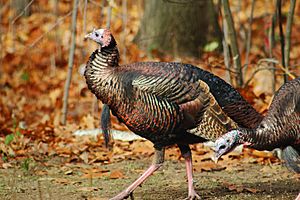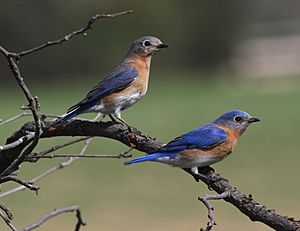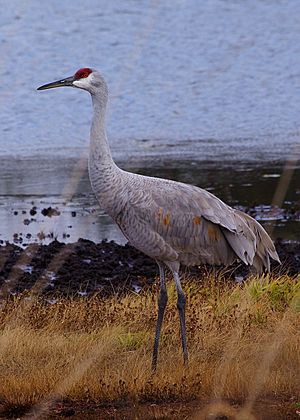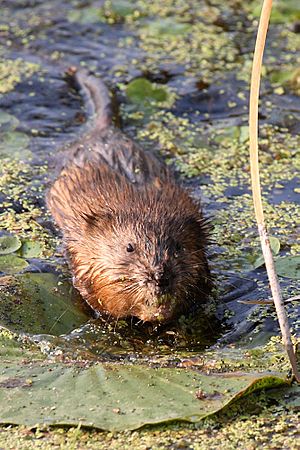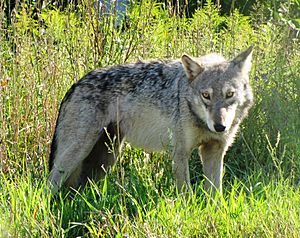List of fauna of Michigan facts for kids
Welcome to a list of amazing animals found in the U.S. state of Michigan! This includes creatures that live only in Michigan and those that can be found in many other places too. If you're curious about animals that need special protection in Michigan, you can also check out the List of threatened fauna of Michigan.
Contents
Invertebrates: Animals Without Backbones
Invertebrates are animals that don't have a backbone. This huge group includes everything from tiny jellyfish to busy insects and slimy snails.
Jellyfish and Friends (Cnidaria)
- Craspedacusta sowerbyi: This is a type of freshwater jellyfish. It's quite small and clear, so it can be hard to spot in Michigan's lakes and ponds!
Creepy Crawlies (Arthropods)
Arthropods are animals with an exoskeleton (a hard outer shell) and jointed legs. This group includes insects, spiders, and crustaceans.
Spiders and Their Relatives (Arachnids)
- European garden spider: You might see this spider building its big, round web in gardens.
- Misumenops celer: This is a type of crab spider, often found on flowers waiting for insects.
Crabs, Crayfish, and More (Crustaceans)
Crustaceans are mostly water-dwelling arthropods.
- Armadillidium vulgare (common pillbug): These little creatures roll into a ball when they feel threatened, just like a pill!
- Cambarus diogenes (chimney crayfish): This crayfish builds tall mud "chimneys" near its burrow.
- Cambarus robustus (big water crayfish): A larger type of crayfish found in Michigan's waters.
- Creaserinus fodiens (digger crayfish): This crayfish is known for digging burrows.
- Faxonius immunis (calico crayfish): This crayfish has a spotted, or "calico," pattern.
- Faxonius propinquus (northern clearwater crayfish): Often found in clear streams and lakes.
- Faxonius rusticus (rusty crayfish): This crayfish is an invasive species, meaning it's not originally from Michigan and can harm the local environment.
- Faxonius virilis (northern crayfish): A common crayfish species in the northern parts of Michigan.
- Procambarus acutus acutus (white river crawfish): Another type of crayfish found in Michigan.
Insects
Insects are the largest group of arthropods. They have six legs, a body divided into three parts, and usually wings.
Beetles (Coleoptera)
- Brychius hungerfordi: A rare diving beetle found in specific Michigan habitats.
- Cicindela sexguttata: Also known as the six-spotted tiger beetle, it's a fast hunter.
- Colorado potato beetle: This beetle is known for eating potato plants.
- Desmocerus palliatus: The elderberry borer, a colorful beetle.
- Harmonia axyridis: The multicolored Asian lady beetle, often seen in homes.
- Megacyllene robiniae: The locust borer, which targets black locust trees.
- Neandra brunnea: A type of longhorn beetle.
- Rhyssomatus lineaticollis: A weevil that feeds on milkweed.
Flies (Diptera)
- Chironomus plumosus: A common type of non-biting midge, often seen in large swarms.
Mantises (Dictyoptera)
- Chinese mantis (introduced): This large praying mantis was brought to Michigan from other parts of the world.
True Bugs (Hemiptera)
- Adelphocoris lineolatus: The alfalfa plant bug.
- Green stink bug: Known for releasing a bad smell when disturbed.
- Large milkweed bug: Often found on milkweed plants.
Ants, Bees, and Wasps (Hymenoptera)
- Dolichovespula maculata: The bald-faced hornet, known for its large paper nests.
- Polistes dominulus: The European paper wasp, an introduced species.
- Polistes exclamans: A type of paper wasp.
- Polistes fuscatus: The dark paper wasp.
- Polistes metricus: Another common paper wasp.
- Vespa crabro: The European hornet, a large wasp.
- Vespula maculifrons: The eastern yellowjacket, a common stinging wasp.
Butterflies and Moths (Lepidoptera)
Michigan is home to many beautiful butterflies and moths, from tiny ones to large, colorful species.
Dragonflies and Damselflies (Odonata)
- Blue dasher: A common and colorful dragonfly.
- Erythemis simplicicollis: The eastern pondhawk, a green dragonfly.
- Green darner: A large, fast-flying dragonfly.
- Ischnura posita: The fragile forktail, a small damselfly.
- Lestes vigilax: The swamp spreadwing, a damselfly found near wetlands.
- Sympetrum vicinum: The autumn meadowhawk, often seen in late summer and fall.
- Variable dancer: A damselfly with varying colors.
Grasshoppers and Crickets (Orthoptera)
- Differential grasshopper: A large grasshopper common in open areas.
- Gryllus pennsylvanicus: The fall field cricket, known for its chirping sounds.
- Barrens or spotted-winged grasshopper: A grasshopper found in sandy or open habitats.
- Spur-throat grasshopper: Named for a small spur on its throat.
- Blue-legged locust: A type of grasshopper.
- Hebard's green-legged locust: Another type of locust.
- Hoosier locust: A locust species.
- Atlantic-coast or long-horned grasshopper: A grasshopper with long antennae.
- Lake Huron locust: A locust found near Lake Huron.
- Secretive locust: A less commonly seen locust.
- Post-oak grasshopper: Found in areas with oak trees.
- Ceuthophilus silvestris: A type of camel cricket.
- Ceuthophilus uhleri: Another camel cricket species.
- Woodland meadow katydid: A katydid found in wooded meadows.
- Bog conehead: A katydid with a cone-shaped head, found in bogs.
- Neoconocephalus retusus: The round-tipped conehead katydid.
- Eelicate meadow katydid: A delicate-looking katydid.
- Pine katydid: Found in pine forests.
- Davis's shield-bearer: A large katydid.
- Melodious ground cricket: A cricket known for its pleasant chirping.
- Tamarack tree cricket: Found in tamarack trees.
- Pine tree cricket: Lives in pine trees.
Springtails (Entognatha)
- Willowsia nigromaculata: A common springtail, tiny creatures often found in soil or decaying matter.
Snails and Clams (Molluscs)
Molluscs are soft-bodied animals, many of which have shells.
- Planogyra asteriscus (eastern flat-whorl): A very small land snail with a flat, coiled shell.
- Giant floater (Pyganodon grandis): A large freshwater mussel found in lakes and rivers.
- Northern riffleshell (Epioblasma torulosa): A freshwater mussel that is endangered.
- Quagga mussel (Dreissena rostriformis bugensis): An invasive species that can cause problems in Michigan's waterways.
- Zebra mussel (Dreissena polymorpha): Another invasive species, known for attaching to surfaces and clogging pipes.
Vertebrates: Animals With Backbones
Vertebrates are animals that have a backbone or spine. This group includes fish, amphibians, reptiles, birds, and mammals.
Frogs, Toads, and Salamanders (Amphibians)
Michigan's amphibians live part of their lives in water and part on land. They include many types of frogs, toads, and salamanders.
Birds
Michigan is a great place for birdwatching, with many different species flying through its skies, nesting in its forests, and wading in its waters. You can find a much longer list at Michigan Breeding birds Atlas, Appendix 3.
- American bittern (Botanus lentiginosus)
- American black duck (Anas rubripes)
- American coot (Fulica americana)
- American crow (Corvus brachyrhynchos)
- American goldfinch (Carduelis tristis)
- American kestrel (Falco sparverius)
- American white pelican (Pelecanus erythrorhynchos)
- Bald eagle (Haliaeetus leucocephalus)
- Baltimore oriole (Icterus galbula)
- Barn owl (Tyto alba)
- Belted kingfisher (Megaceryle alcyon)
- Black tern (Chlidonias niger)
- Black-backed woodpecker (Picoides arcticus)
- Black-capped chickadee (Poecile atricapillus)
- Snow goose (Chen caerulescens)
- Bobolink (Dolichonyx oryzivorus)
- Bobwhite quail (Colinus virginianus)
- Boreal chickadee (Poecile hudsonicus)
- Brant goose (Branta bernicla)
- Bonaparte's gull (Larus philadelphia)
- Broad-winged hawk (Buteo platypterus)
- Brown-headed cowbird (Molothrus ater)
- Canada goose (Branta canadensis)
- Canvasback (Aythya valisineria)
- Cardinal (Cardinalis cardinalis)
- Caspian tern (Sterna caspia)
- Common loon (Gavia immer)
- Common nighthawk (Chordeiles minor)
- Common raven (Corvis corax)
- Common tern (Sterna hirundo)
- Double-crested cormorant (Phalacrocorax auritus)
- Dovekie (Alle alle)
- Downy woodpecker (Dryobates pubescens)
- Eastern meadowlark (Sturnella magna)
- Forster's tern (Sterna forsteri)
- Gray catbird (Dumetella carolinensis)
- Great blue heron (Ardea herodias)
- Great egret (Ardea alba)
- Great horned owl (Bubo virginianus)
- Greater yellowlegs (Tringa flavipes)
- Green heron (Butorides virescens)
- Hairy woodpecker
- Henslow's sparrow (Ammodramus henslowii)
- Herring gull (Larus argentantus)
- House finch
- House sparrow
- King eider (Somateria spectabilis)
- King rail (Rallus elegans)
- Kirtland's warbler (Dendroica kirtlandii)
- Least bittern (Ixobrychus exilis)
- Lesser yellowlegs (Tringa melanoleuca)
- Loggerhead shrike (Lanius ludovicianus)
- Long-eared owl (Asio otis)
- Long-tailed duck (Clangula hyemalis)
- Mallard
- Merganser
- Merlin (Falco columbarius)
- Mourning dove (Zenaida macroura)
- Mute swan
- Northern flicker
- Northern gannet (Morus bassanus) (rare in state)
- Northern goshawk
- Northern harrier (Circus cyaneus)
- Northern mockingbird (Mimus polyglottos)
- Northern shoveler (Spatula clypeata)
- Osprey (Pandion haliaetus)
- Peregrine falcon (Falco peregrinus)
- Pheasant
- Pigeon
- Pileated woodpecker (Dryocuopus pileatus)
- Pintail duck (Anas acuta)
- Piping plover (Charadrius melodus)
- Prairie warbler (Dendroica discolor)
- Purple martin (Progne subis)
- Red crossbill (Loxia curvirostra)
- Redhead duck
- Red-shouldered hawk (Buteo lineatus)
- Red-tailed hawk
- Red-throated loon
- Red-winged blackbird
- Ring-billed gull (Larus delawarensis)
- Robin
- Ross's goose
- Ruby-throated hummingbird
- Ruffed grouse
- Rusty blackbird (Euphagus carolinus)
- Sandhill crane (Grus canadensis)
- Scarlet tanager (Piranga olivacea)
- Scaup
- Scoters
- Sharptailed grouse
- Short-eared owl (Asio flammeus)
- Snipe
- Snowy owl
- Sora rail
- Spruce grouse (Canachites canadensis)
- Trumpeter swan (Cygnus buccinator)
- Tundra swan
- Turkey vulture (Cathartes aura)
- Upland sandpiper (Bartramia longicauda)
- Virginia rail
- Western meadowlark (Sturnella neglecta)
- White-fronted goose
- White pelican
- Wild turkey (Meleagris gallopavo)
- Willet (Tringa semipalmata)
- Wilson's phalarope (Phalaropus tricolor)
- Wood duck
- Woodcock
- Yellow rail (Corturnicops noveboracensis)
- Yellow-throated warbler (Dendroica dominica)
Birds That Are No Longer Here (Extinct)
- Passenger pigeon (Ectopistes migratorius): Once very common, these birds are now extinct.
- Heath hen (Tympanuchus cupido cupido): A type of grouse that is now extinct.
- Carolina parakeet (Conuropsis carolinensis): The only native parrot species in the eastern U.S., now extinct.
Fish
Michigan is known for its many lakes and rivers, which are home to a wide variety of fish, from tiny minnows to large game fish.
- Alewife (Alosa pseudoharengus)
- American gizzard shad (Dorosoma cepedianum)
- American eel (Anguilla rostrata)
- Atlantic salmon (Salmo salar)
- Black buffalo (Ictiobus Niger)
- Black bullhead (Ameiurus melas)
- Black crappie (Pomoxis nigromaculatus)
- Bluegill (Lepomis macrochirus)
- Bigmouth buffalo (Ictiobus cyprinellus)
- Brook (five-spined) stickleback (Culaea inconstans)
- Brook silverside (Labidesthes sicculus)
- Brook trout (Salvelinus fontinalis)
- Brown bullhead (Ameiurus nebulosus)
- Brown trout (Salmo trutta)
- Bowfin (Amia calve)
- Burbot (Lota lota)
- Channel catfish (Ictalurus punctatus)
- Chinook salmon (Oncorhynchus tshawytscha)
- Coho salmon (Oncorhynchus kisutch)
- Common carp (Cyprinus carpio)
- Dace
- Darter
- Flathead catfish (Pylodictis olivaris)
- Freshwater drum (Aplodinotus grunniens)
- Goldfish (Carassius auratus)
- Grass carp (Ctenopharyngodon idella)
- Grass pickerel (Esox americanus vermiculatus)
- Green sunfish (Lepomis cyanellus)
- Killifish
- Lake herring or northern cisco (Coregonus artedi)
- Lake sturgeon (Acipenser fulvescens)
- Lake trout (Salvelinus namaycush)
- Lake whitefish (Coregonus clupeaformis)
- Largemouth bass (Micropterus salmoides)
- Longear sunfish (Lepomis megalotis)
- Longnose gar (Lepisosteus osseus)
- Longnose sucker (Catostomus catostomus)
- Menominee or round whitefish (Prosopium cylindraceum)
- Mooneye (Hiodon tergisus)
- Muskellunge (Esox masquinongy)
- Ninespine stickleback (Pungitius pungitius)
- Northern hogsucker (Hypentelium nigricans)
- Northern pike (Esox lucius)
- Orangespotted sunfish (Lepomis humilis)
- Oriental weatherfish (Misgurnus anguillicaudatus)
- Pink salmon (Oncorhynchus gorbuscha)
- Pumpkinseed (Lepomis gibbosus)
- Quillback (Carpiodes cyprinus)
- Rainbow darter (Etheostoma caeruleum)
- Rainbow smelt (Osmerus mordax)
- Rainbow trout or steelhead (Oncorhynchus mykiss)
- Redear sunfish (Lepomis microlophus)
- River redhorse (Moxostoma carinatum)
- Rock bass (Ambloplites rupestris)
- Round goby (Neogobius melanostomus)
- Ruffe (Gymnocephalus cernuus)
- Sauger (Sander canadensis)
- Saugeye (Sander canadensis × Sander vitreus)
- Sculpin
- Sea lamprey (Petromyzon marinus)
- Shiner
- Smallmouth bass (Micropterus dolomieu)
- Smallmouth buffalo (Ictiobus bubalus)
- Sockeye or kokanee (Oncorhynchus nerka)
- Splake (Salvelinus namaycush × Salvelinus fontinalis)
- Spotted gar (Lepisosteus oculatus)
- Stonecat (Noturus flavus)
- Threespine stickleback (Gasterosteus aculeatus)
- Topminnow
- Trout-perch (Percopsis omiscomaycus)
- Tubenose goby (Proterorhinus marmoratus)
- Walleye (Sander vitreus)
- Warmouth (Lepomis gulosus)
- Western mosquitofish (Gambusia affinis)
- White bass (Morone chrysops)
- White crappie (Pomoxis annularis)
- White perch (Morone americana)
- White sucker (Catostomus commersonii)
- Yellow bullhead (Ameiurus natalis)
- Yellow perch (Perca flavescens)
Fish That Are No Longer Here (Extinct)
- Bigeye chub (Hybopsis amblops)
- Bluepike (Sander vitreus glaucus)
- Blackfin cisco(Coregonus nigrpinnis)
- Deepwater cisco (Coregonus johannae)
- Grayling (Thymallus arcticus)
- Ironcolor shiner (Notropis chalybaeus)
- Mississippi paddlefish (Polyodon spathula)
- Shortnose cisco (Coregonus reighardi)
- Weed shiner (Notropis texanus)
Mammals
Michigan is home to many different kinds of mammals, from tiny mice to large deer and bears.
- American badger
- American bison (extirpated): These huge animals once lived in Michigan but are no longer found here naturally.
- American black bear
- American ermine
- American marten
- American red squirrel
- American water shrew
- Big brown bat
- Beaver
- Bobcat
- Brown rat (introduced): These rats were brought to Michigan by humans.
- Canada lynx
- Cinereus shrew
- Cougar (extirpated, but vagrants sighted): Cougars used to live in Michigan but are mostly gone, though a few might pass through.
- Coyote
- Deer mouse
- Eastern cottontail rabbit
- Eastern gray squirrel
- Eastern mole
- Eastern chipmunk
- Eastern red bat
- Eastern wolf (naturally repopulated): Wolves have made a comeback in Michigan.
- Elk (reintroduced): Elk were brought back to Michigan after disappearing.
- Fisher
- Fox squirrel
- Gray fox
- Groundhog
- Hoary bat
- House mouse (introduced): Like brown rats, house mice were introduced by humans.
- Indiana bat
- Least chipmunk
- Least weasel
- Little brown bat
- Long-tailed weasel
- Meadow vole
- Meadow jumping mouse
- Mink
- Moose (reintroduced): Moose have also been reintroduced to Michigan.
- Muskrat
- North American river otter
- Northern short-tailed shrew
- North American porcupine
- Prairie vole
- Raccoon
- Red fox
- Silver-haired bat
- Sika deer (introduced): These deer were brought to Michigan from Asia.
- Snowshoe hare
- Southern bog lemming
- Southern flying squirrel
- Star-nosed mole
- Striped skunk
- Thirteen-lined ground squirrel
- Virginia opossum
- White-footed mouse
- White-tailed deer
- Wolverine (extirpated): Wolverines are no longer found naturally in Michigan.
- Woodland caribou (extirpated): These caribou once lived in Michigan but are now gone.
- Woodland jumping mouse
- Woodland vole
Snakes, Turtles, and Lizards (Reptiles)
Michigan's reptiles include various snakes, turtles, and a few types of lizards. They are cold-blooded animals, meaning their body temperature depends on their surroundings.


